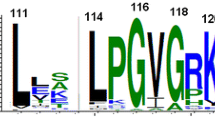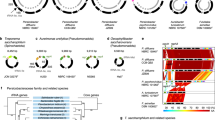Abstract
The common understanding of the function of RecD, as derived predominantly from studies in Escherichia coli, is that RecD is one of three enzymes in the RecBCD double-stranded break repair DNA recombination complex. However, comparative genomics has revealed that many organisms possess a recD gene even though the other members of the complex, recB and recC, are not present. Further, bioinformatic analyses have shown that there is substantial sequence dissimilarity between recD genes associated with recB and recC (recD1), and those that are not associated with recBC (recD2). Deinococcus radiodurans, known for its extraordinary DNA repair capability, is one such organism that does not possess either recB or recC, and yet does possess a recD gene. The recD of D. radiodurans was deleted and this mutant was shown to have a capacity to repair double-stranded DNA breaks equivalent to wild-type. The phylogenetic history of recD was studied using a dataset of 120 recD genes from 91 fully sequenced species. The analysis focused upon the role of gene duplication and functional genomic context in the evolution of recD2, which appears to have undergone numerous independent events resulting in duplicate recD2 genes. The role of RecD as part of the RecBCD complex appears to have a divergence from an earlier ancestral RecD function still preserved in many species including D. radiodurans.




Similar content being viewed by others
References
Amundsen SK, Taylor AF, Chaudhury AM, Smith GR (1986) recD: the gene for an essential third subunit of exonuclease V. Proc Natl Acad Sci USA 83:5558–5562
Battista JR (1997) Against all odds: the survival strategies of Deinococcus radiodurans. Annu Rev Microbiol 51:203–224
Benzer S (1961) On the topography of the genetic fine structure. Proc Natl Acad Sci USA 47:403–415
Bidle KA, Bartlett DH (1999) RecD function is required for high-pressure growth of a deep-sea bacterium. J Bacteriol 181:2330–2337
Biek DP, Cohen SN (1986) Identification and characterization of recD, a gene affecting plasmid maintenance and recombination in Escherichia coli. J Bacteriol 167:594–603
Blount ZD, Borland CZ, Lenski RE (2008) Historical contingency and the evolution of a key innovation in an experimental population of Escherichia coli. Proc Natl Acad Sci USA 105:7899–7906
Boussau B, Blanquart S, Necsulea A, Lartillot N, Gouy M (2008) Parallel adaptations to high temperatures in the Archaean eon. Nature 456:942–946
Chaudhury AM, Smith GR (1984) A new class of Escherichia coli recBC mutants: implications for the role of RecBC enzyme in homologous recombination. Proc Natl Acad Sci USA 81:7850–7854
Chaussee MS, Wilson J, Hill SA (1999) Characterization of the recD gene of Neisseria gonorrhoeae MS11 and the effect of recD inactivation on pilin variation and DNA transformation. Microbiology 145(Pt 2):389–400
Chedin F, Kowalczykowski SC (2002) A novel family of regulated helicases/nucleases from Gram-positive bacteria: insights into the initiation of DNA recombination. Mol Microbiol 43:823–834
Ciccarelli FD, Doerks T, Von Mering C, Creevey CJ, Snel B, Bork P (2006) Toward automatic reconstruction of a highly resolved tree of life. Science 311:1283–1287
Cromie GA (2009) Phylogenetic ubiquity and shuffling of the bacterial RecBCD and AddAB complexes. J Bacteriol 191(16):5076–5084
Dillingham MS, Spies M, Kowalczykowski SC (2003) RecBCD enzyme is a bipolar DNA helicase. Nature 423:893–897
Earl AM, Rankin SK, Kim KP, Lamendola ON, Battista JR (2002) Genetic evidence that the uvsE gene product of Deinococcus radiodurans R1 is a UV damage endonuclease. J Bacteriol 184:1003–1009
Emmerson PT (1968) Recombination deficient mutants of Escherichia coli K-12 that map between thyA and argA. Genetics 60:19–30
Felsenstein J (1989) PHYLIP—Phylogeny Inference Package (Version 3.2). Cladistics 5:164–166
Finn RD, Tate J, Mistry J, Coggill PC, Sammut SJ, Hotz H-R, Ceric G, Forslund K, Eddy SR, Sonnhammer EL, Bateman A (2008) The Pfam protein families database. Nucleic Acids Res 36:D281–D288
Howard-Flanders P, Theriot L (1966) Mutants of Escherichia coli K-12 defective in DNA repair and in genetic recombination. Genetics 53:1137–1150
Hughes AL (1994) The evolution of functionally novel proteins after gene duplication. Proc Biol Sci 256:119–124
Huson DH, Richter DC, Rausch C, Dezulian T, Franz M, Rupp R (2007) Dendroscope—an interactive viewer of large phylogenetic trees. BMC Bioinform 8:460
Hutchison CA, Montague MG (2002) Mycoplasmas and the minimal genome concept. In: Razin S, Herrmann R (eds) Molecular biology and pathogenicity of mycoplasmas. Plenum Pub Corp, Jerusalem, pp 221–253
Imlay JA, Linn S (1988) DNA damage and oxygen radical toxicity. Science 240:1302–1309
Khairnar NP, Kamble VA, Misra HS (2008) RecBC enzyme overproduction affects UV and gamma radiation survival of Deinococcus radiodurans. DNA Repair (Amst) 7:40–47
Kickstein E, Harms K, Wackernagel W (2007) Deletions of recBCD or recD influence genetic transformation differently and are lethal together with a recJ deletion in Acinetobacter baylyi. Microbiology 153:2259–2270
Lloyd RG, Porton MC, Buckman C (1988) Effect of recF, recJ, recN, recO and ruv mutations on ultraviolet survival and genetic recombination in a recD strain of Escherichia coli K12. Mol Gen Genet 212:317–324
Lovett ST, Luisi-DeLuca C, Kolodner RD (1988) The genetic dependence of recombination in recD mutants of Escherichia coli. Genetics 120:37–45
Masters CI, Smith MD, Gutman PD, Minton KW (1991) Heterozygosity and instability of amplified chromosomal insertions in the radioresistant bacterium Deinococcus radiodurans. J Bacteriol 173:6110–6117
Mattimore V, Battista JR (1996) Radioresistance of Deinococcus radiodurans: functions necessary to survive ionizing radiation are also necessary to survive prolonged desiccation. J Bacteriol 178:633–637
Mehr IJ, Seifert HS (1998) Differential roles of homologous recombination pathways in Neisseria gonorrhoeae pilin antigenic variation, DNA transformation and DNA repair. Mol Microbiol 30:697–710
Meima R, Lidstrom ME (2000) Characterization of the minimal replicon of a cryptic Deinococcus radiodurans SARK plasmid and development of versatile Escherichia coli–D. radiodurans shuttle vectors. Appl Environ Microbiol 66:3856–3867
Miesel L, Roth JR (1994) Salmonella recD mutations increase recombination in a short sequence transduction assay. J Bacteriol 176:4092–4103
Moseley BE, Copland HJ (1975) Isolation and properties of a recombination-deficient mutant of Micrococcus radiodurans. J Bacteriol 121:422–428
Peterson JD, Umayam LA, Dickinson TM, Hickey EK, White O (2001) The comprehensive microbial resource. Nucleic Acids Res 29:123–125
Regha K, Satapathy AK, Ray MK (2005) RecD plays an essential function during growth at low temperature in the antarctic bacterium Pseudomonas syringae Lz4W. Genetics 170:1473–1484
Rocha EP, Cornet E, Michel B (2005) Comparative and evolutionary analysis of the bacterial homologous recombination systems. PLoS Genet 1:e15
Saikrishnan K, Griffiths SP, Cook N, Court R, Wigley DB (2008) DNA binding to RecD: role of the 1B domain in SF1B helicase activity. EMBO J 27:2222–2229
Schmidt HA, Strimmer K, Vingron M, von Haeseler A (2002) TREE-PUZZLE: maximum likelihood phylogenetic analysis using quartets and parallel computing. Bioinformatics 18:502–504
Servinsky MD, Julin DA (2007) Effect of a recD mutation on DNA damage resistance and transformation in Deinococcus radiodurans. J Bacteriol 189:5101–5107
Singleton MR, Dillingham MS, Gaudier M, Kowalczykowski SC, Wigley DB (2004) Crystal structure of RecBCD enzyme reveals a machine for processing DNA breaks. Nature 432:187–193
Slade D, Linder A, Paul G, Radman M (2009) Recombination and replication in DNA repair of heavily irradiated Deinococcus radiodurans. Cell 136:1044–1055
Spies M, Kowalczykowski SC (2005) Homologous recombination by the RecBCD and RecF pathways. In: Higgins NP (ed) The bacterial chromosome. ASM Press, Washington, DC, pp 389–403
Takami H, Nakasone K, Takaki Y, Maeno G, Sasaki R, Masui N, Fuji F, Hirama C, Nakamura Y, Ogasawara N, Kuhara S, Horikoshi K (2000) Complete genome sequence of the alkaliphilic bacterium Bacillus halodurans and genomic sequence comparison with Bacillus subtilis. Nucleic Acids Res 28:4317–4331
Tatusov RL, Fedorova ND, Jackson JD, Jacobs AR, Kiryutin B, Koonin EV, Krylov DM, Mazumder R, Mekhedov SL, Nikolskaya AN, Rao BS, Smirnov S, Sverdlov AV, Vasudevan S, Wolf YI, Yin JJ, Natale DA (2003) The COG database: an updated version includes eukaryotes. BMC Bioinformatics 4:1–14
Taylor AF, Smith GR (2003) RecBCD enzyme is a DNA helicase with fast and slow motors of opposite polarity. Nature 423:889–893
Thaler DS, Sampson E, Siddiqi I, Rosenberg SM, Thomason LC, Stahl FW, Stahl MM (1989) Recombination of bacteriophage lambda in recD mutants of Escherichia coli. Genome 31:53–67
Thompson JD, Gibson TJ, Plewniak F, Jeanmougin F, Higgins DG (1997) The ClustalX windows interface: flexible strategies for multiple sequence alignment aided by quality analysis tools. Nucleic Acids Res 25:4876–4882
White O, Eisen JA, Heidelberg JF, Hickey EK, Peterson JD, Dodson RJ, Haft DH, Gwinn ML, Nelson WC, Richardson DL, Moffat KS, Qin H, Jiang L, Pamphile W, Crosby M, Shen M, Vamathevan JJ, Lam P, McDonald L, Utterback T, Zalewski C, Makarova KS, Aravind L, Daly MJ, Fraser CM et al (1999) Genome sequence of the radioresistant bacterium Deinococcus radiodurans R1. Science 286:1571–1577
Willetts NS, Mount DW (1969) Genetic analysis of recombination-deficient mutants of Escherichia coli K-12 carrying rec mutations cotransducible with thyA. J Bacteriol 100:923–934
Yu M, Souaya J, Julin DA (1998) The 30-kDa C-terminal domain of the RecB protein is critical for the nuclease activity, but not the helicase activity, of the RecBCD enzyme from Escherichia coli. Proc Natl Acad Sci USA 95:981–986
Zhang J (2003) Evolution by gene duplication: an update. Trends Ecol Evol 18:292–298
Zhou Q, Zhang X, Xu H, Xu B, Hua Y (2007) A new role of Deinococcus radiodurans RecD in antioxidant pathway. FEMS Microbiol Lett 271:118–125
Acknowledgments
This research was supported by the Office of Science (BER), U.S. Department of Energy, Grant No. DE-FC02-02ER63453. We graciously acknowledge Dr. John Battista and Dr. Mary Lidstrom for generously providing reagents. We thank Mr. Jim Puhl of NIST for his help with the ionizing radiation experiments. We are grateful to members of the Synthetic Biology group at the J. Craig Venter Institute, especially Dr. John Glass, Dr. Chuck Merryman and Ms. Cindi Pfannkoch for stimulating discussions. We thank Mikkel Algire and Radha Krishnakumar for critical reading of this manuscript. We thank Jonathan Badger for his phylipFasta script and general help and advice on constructing a recD phylogeny.
Author information
Authors and Affiliations
Corresponding authors
Electronic supplementary material
Below is the link to the electronic supplementary material.
Rights and permissions
About this article
Cite this article
Montague, M., Barnes, C., Smith, H.O. et al. The Evolution of RecD Outside of the RecBCD Complex. J Mol Evol 69, 360–371 (2009). https://doi.org/10.1007/s00239-009-9290-x
Received:
Accepted:
Published:
Issue Date:
DOI: https://doi.org/10.1007/s00239-009-9290-x




